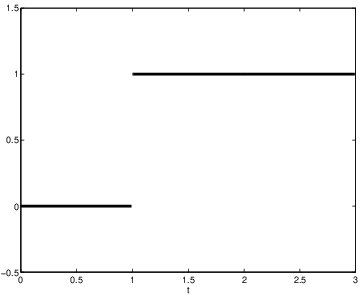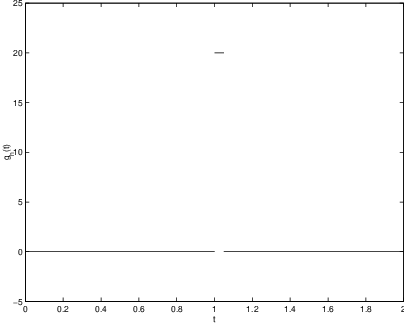This section divides into three parts. In the first part, we give an explicit formula for the Laplace transform and verify that this formula satisfies properties (??). In the second part, we compute a table of Laplace transforms for a number of special functions including step functions and impulse functions. In the third part we discuss two properties of Laplace transforms that are useful when computing inverse Laplace transforms of functions of the type that appear when solving forced second order equations.
Note that the Laplace transform is an improper integral — which implies that some care must be taken when discussing its properties. Indeed, for some functions the Laplace transform does not exist for all values of . What usually happens is that the Laplace transform exists for all values of larger than some number . As an example, we compute (??) directly using Definition ??. Let and compute
The Laplace Transform is Linear
The first step in verifying properties (??) is to show that the Laplace transform is linear, that is, to show that (??)(a) holds.
- Proof
- Using properties of integrals we obtain for each
A similar computation verifies that commutes with scalar multiplication.
The Derivative Property of Laplace Transforms is Valid
Next we verify the important derivative property (??)(c) of the Laplace transform.
- the Laplace transform exists for ;
- Proof
- (a) Observe that by the assumption on the growth of we have for
Hence the Laplace transform exists for .
(b) First note that Now use the definition of improper integrals and integration by parts to compute
for .
Finally, we remark that (??)(b) is valid, but that its proof is beyond the scope of this course. One method of proof is to develop an explicit integral formula for the inverse Laplace transform.
A Table of Laplace Transforms
In order to solve differential equations using the method of Laplace transforms, we need to have a table of Laplace transforms readily available. We now compute the Laplace transform for the functions in Table ??. These functions include the discontinuous step function where is a positive constant and the hitherto undefined Dirac delta function . See Figure ?? for a graph of .
We derive some of these formulas by using the Laplace transform formulas for derivatives (??)(c) and (??). (We could compute these transforms directly by integration from Definition ??, but the method we choose is simpler and illustrates the power of the derivative formulas.) Note that we have already computed the Laplace transforms of the first two functions in Table ?? when deriving (??).
The Laplace Transforms: and
To compute where , observe that is a solution to the initial value problem
The Laplace Transform:
Next, we compute by applying (??)(c) times. That is,
The Laplace Transform:
We compute the Laplace transform of the step function by direct integration.
The Laplace Transform of Dirac Delta Functions
Suppose that a strong external force is applied at time , but only for a very short time . Then the forcing function is approximated by
The graph of is given in Figure ??. It is not clear how to take the limit of as in (??), since this limit leads to a ‘function’ that is infinity at and zero elsewhere. Despite this difficulty, the limit is called the Dirac delta function and is denoted by . We compute the Laplace transform of the by first computing the Laplace transform of the approximating function and then taking the limit of the Laplace transforms of the approximation as .The Laplace transform of the approximating function is found using the linearity of and Table ??, that is, We claim that from which it follows that This result justifies writing
To verify the claim, let and recall that Since , it follows that as claimed.Additional Techniques for Laplace Transforms
At the end of Section ?? we showed that when solving second order differential equations by the method of Laplace transforms, it is necessary to compute inverse Laplace transforms of functions like
and where is the Laplace transform of the forcing function . See (??).Inverse Laplace Transforms of Shifted Functions
The next proposition enables us to calculate inverse Laplace transforms for functions of type (??).
- Proof
- To verify (a) compute Part (b) follows by applying the inverse Laplace transform to both sides of (a).
For example, suppose that we want to compute the inverse Laplace transform of
The first step in this computation is to write the denominator as the sum of two squares and to shift the numerator. That is, We can now find the inverse Laplace transform of the right hand side of (??). Except for the shift of to , the rearranged expression (??) is one whose inverse Laplace transform can be read from Table ??. More precisely, let so that the right hand side of (??) is . Using Table ?? the inverse Laplace transform of is Using Proposition ??(b) we can compute the inverse Laplace transform of as That is,Another Useful Property of the Laplace Transform
Next, we examine the Laplace transform of a function that is multiplied by the jump function and by doing so we will be able to compute the inverse Laplace transform of functions like (??) when is the Laplace transform of a discontinuous forcing function.
- Proof
- (a) Compute On substituting for we obtain Part (b) follows by applying the inverse Laplace transform to both sides of (a).
As an application of Proposition ??(b), we find that
Exercises
In Exercises ?? – ?? compute the Laplace transform for each function :
In Exercises ?? – ??, use Laplace transforms to compute the solution to the given initial value problem.

